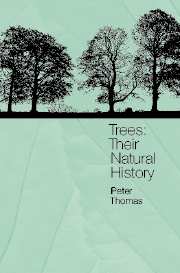Book contents
- Frontmatter
- Contents
- Preface
- 1 An overview
- 2 Leaves: the food producers
- 3 Trunk and branches: more than a connecting drainpipe
- 4 Roots: the hidden tree
- 5 Towards the next generation: flowers, fruits and seeds
- 6 The growing tree
- 7 The shape of trees
- 8 The next generation: new trees from old
- 9 Health, damage and death: living in a hostile world
- Further reading
- Index
8 - The next generation: new trees from old
Published online by Cambridge University Press: 05 September 2012
- Frontmatter
- Contents
- Preface
- 1 An overview
- 2 Leaves: the food producers
- 3 Trunk and branches: more than a connecting drainpipe
- 4 Roots: the hidden tree
- 5 Towards the next generation: flowers, fruits and seeds
- 6 The growing tree
- 7 The shape of trees
- 8 The next generation: new trees from old
- 9 Health, damage and death: living in a hostile world
- Further reading
- Index
Summary
In Chapter 5 we followed the processes of reproduction through to the arrival of the seed on the ground. Here we will look at germination and early survival of the seedling, and ways of producing new trees without resorting to seed.
The Seed
Seeds remind me of spaceships: they contain everything they need to colonise new worlds given favourable conditions and water once they arrive. The outside is covered by the seed coat (the testa), designed to protect the contents (see Figure 5.13). At the centre of the seed is the embryo, consisting of little more than a miniature root (the radicle) and shoot (the plumule). The rest of the seed is taken up with the food supply to keep the embryo alive before it germinates and to sustain early growth before photosynthesis takes over. This food is stored usually in the cotyledons (seed leaves), although some store it outside the cotyledons in the endosperm (which can be thought of as a short-lived half-brother of the embryo; all flowering plants have endosperm but in most it is used up quickly). In ash (Fraxinus excelsior), for example, the cotyledons are small, surrounded by endosperm, but in oak (Quercus spp.) the cotyledons are bloated and fill the seed with no remaining sign of the endosperm. The best example of endosperm is in the coconut (Cocos nucifera): part liquid (the milk) and part solid (the flesh).
- Type
- Chapter
- Information
- TreesTheir Natural History, pp. 213 - 230Publisher: Cambridge University PressPrint publication year: 2000



